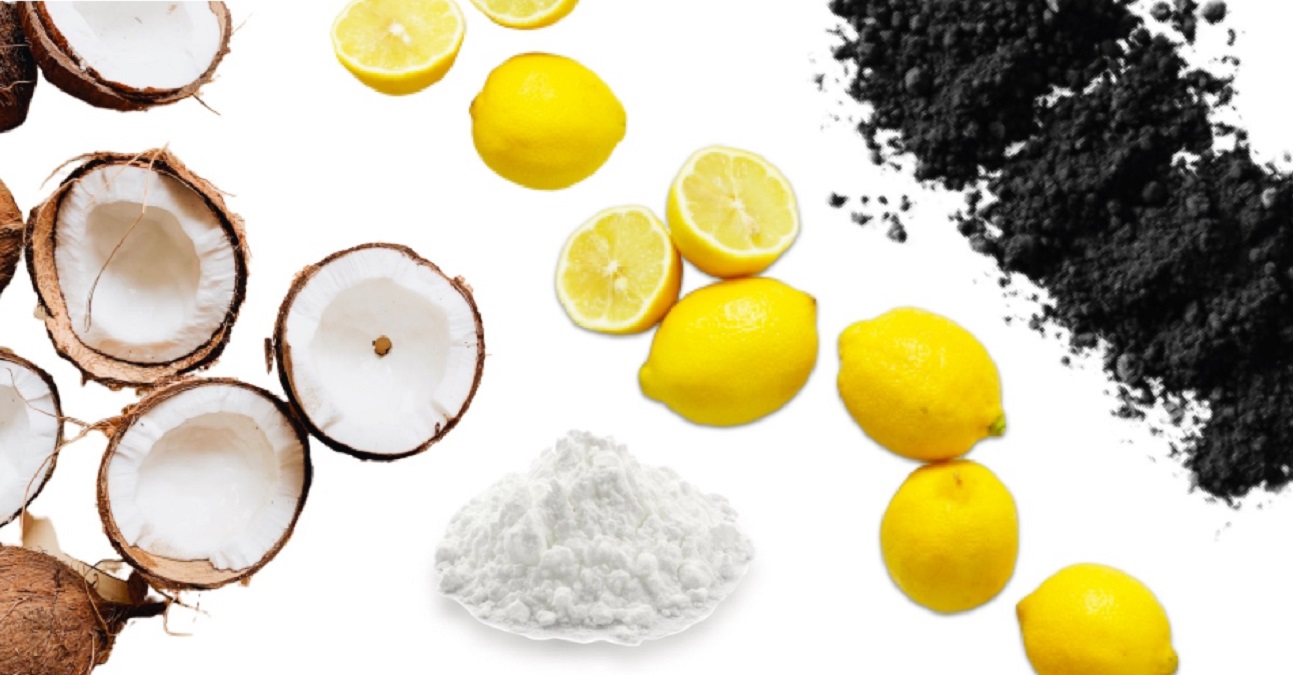If you’ve ever logged onto Pinterest or any other social media platform, you’ve no doubt seen some of the many trends, tricks, and recipes for easy, cheap, "do-it-yourself teeth whitening” treatments.
We’ve invited aesthetic dentist, Dr. Jaimeé Morgan, to discuss some of these popular at-home teeth whitening remedies to let us know what works, what doesn’t, what is safe, and what to avoid.
DIY Trend #1: Brushing with Activated Charcoal

Dr. Jaimeé Morgan: "My big question is “why?” There’s no science to show that brushing one’s teeth with activated charcoal is better, safer, or more effective than toothpaste."
A recent study review published by the British Dental Journal1 and reported by the BBC News website also concludes that there is no scientific evidence to support the benefits of brushing teeth with charcoal toothpastes, and alerts that these products can cause considerable damage to teeth, including increasing the risk of decay and staining. The report adds that these pastes are more abrasive than regular toothpastes, potentially posing a risk to enamel and gums, and recommends the use a regular fluoride toothpaste instead and going to the dentist to whiten your teeth in a safe and effective way.
Dr. Morgan adds that "it’s a widely known problem among dentists that brushing your teeth with activated charcoal a big mess, but it also likes to settle at the gingival margins. My hygienists then have to go in and scrape it out from the patient’s gum line. It’s very difficult to get out! In fact, my office manager and hygienist gave brushing with activated charcoal paste a whirl and the results weren’t great, to say the least. We even used a plaque indicator after she brushed with the charcoal paste to show us how effective the paste was and the pictures speak for themselves."
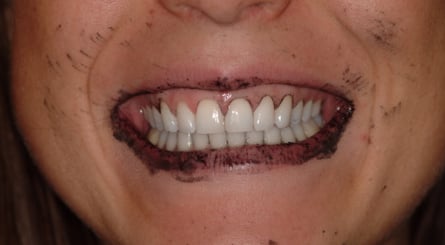

As you can see, after brushing with activated charcoal and rinsing, difficult to remove charcoal residue is left in the patient’s gingival margins and on the patient's teeth. Dr. Morgan applied plaque indicator to the patients’ teeth after rinsing to show the effectiveness of the charcoal. The purple residue indicates leftover plaque on the patient’s teeth.
The only substance proven to actually whiten tooth enamel color is peroxide—both hydrogen peroxide and carbamide peroxide. Although the abrasiveness of the charcoal may help remove existing stains, it cannot actually lighten the color of the tooth. In fact, patients that brush with charcoal risk abrading their enamel too much—something that cannot be repaired once damaged. Furthermore, many people that brush with activated charcoal may experience a kind of illusion that their teeth are in fact whiter due to the contrast of the black charcoal residue (often left in the gums and between the teeth because it is very difficult to remove). This contrast, comparable to wearing a bright red lipstick with blue undertones that makes the teeth appear whiter, is simply a trick that the color of the substance plays on the eye when its placed next to the teeth. Skip the charcoal and go straight for the peroxide or gentle abrasion whitening toothpastes like Opalescence Whitening Toothpaste, which removes surface stains without damaging or scratching the enamel, along with a professional whitening system like Opalescence Boost in-office whitening or Opalescence Go take-home whitening for guaranteed sparkling results!
DIY Trend #2: Oil Pulling Teeth Whitening
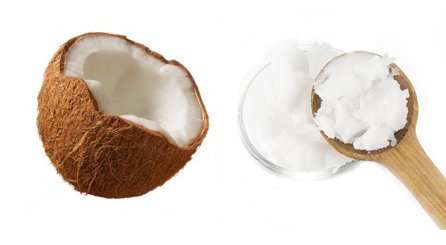
Oil pulling, or swishing coconut oil around in the mouth and between the teeth for 20 minutes, has become a popular fad for cleansing and whitening teeth. Dr. Jaimeé Morgan put it to the test.
Dr. Jaimeé Morgan: "Oil pulling has been touted by some as a means to kill bacteria, remove plaque, freshen breath, and whiten teeth. But it takes 20 minutes! How are people supposed to fit this into their busy schedules? It’s easier to brush for three minutes, which would be more effective anyway. Also, if oil pulling is supposed to whiten the teeth and remove plaque, shouldn’t it be effective in removing the staining from the activated charcoal experiment as well as plaque and plaque indicator? We tried it, and after brushing with activated charcoal, applying plaque indicator, and oil pulling, the staining, plaque, and charcoal residue were all still present at the gum line. A toothbrush and a good toothpaste, like Opalescence Whitening Toothpaste, would have done a far better job."
The 3,000 year-old Ayurvedic practice of oil pulling (swishing a tablespoon of oil such as coconut or safflower oil around in the mouth for 20 minutes or so) is theoretically supposed to cleanse the teeth and gums of bacteria by clinging to the cell membranes in the mouth and when discarded (or, spit out), the bad bacteria in the mouth is claimed to go down the drain along with the oil. It’s also said to whiten teeth, improve breath, reduce headaches, clear the skin, and increase energy. Sounds like magic, right? Does it work? Well, the answer is…we don’t know. There is no data to prove or disprove the benefits of consistent oil pulling. All purported benefits are supported by purely anecdotal evidence. On the contrary, there’s plenty of data and studies to support the fact that brushing and flossing regularly, visiting the dentist, and whitening with a professional, dentist-supervised whitening system like Ultradent’s Opalescence Boost in-office whitening treatment or Opalescence Go take-home whitening are not only proven effective, but also safe. Why waste time on unproven methods when you can stick to the science behind what really works?
DIY Trend #3: Brushing With a Mix of Baking Soda and Lemon Juice
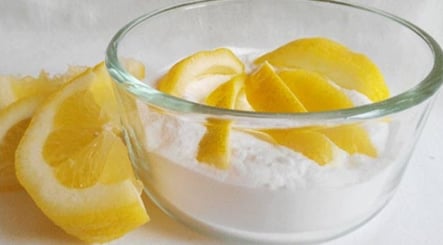
Dr. Morgan warns against brushing with baking soda and lemon juice, as it could damage the enamel if the pH balance isn’t right.
Dr. Jaimeé Morgan: "Baking soda is basic, and lemon juice is acidic, so they could cancel each other out if mixed properly. However, there is the danger that if not mixed properly the acid in the lemon juice could damage the enamel of the tooth, or the abrasiveness of the baking soda could take a toll on the enamel. For patients who like the odor-canceling properties of baking soda, I would advise them to mix it with water and swish with it rather than brush with it." To show the danger of exposing teeth to lemon juice (let alone brushing with it!), Dr. Morgan shared a photo with us of one of her patients who likes to suck on lemons:

This patient experienced significant enamel damage as a result of this habit! Brushing with a homemade mixture of baking soda and lemon juice could prove not only highly damaging for the enamel, but also lead to sensitivity and tooth decay as the acid encourages a pH inside the mouth that fosters bacteria growth. We highly advise against this do-it-yourself trend! Sure, the baking soda may prove harmless, but using a minty toothpaste like Opalescence Whitening Toothpaste is sure to taste and work a lot better! And again, DO NOT brush with lemon juice. It's just a bad idea all around. The goal is to help improve your oral health, not damage it!
The Takeaway:
Dr. Morgan recommends forgetting about these at-home teeth whitening fads and simply brushing consistently with toothpaste. Instead of risking enamel damage, Dr. Morgan had her patient brush with Opalescence Whitening Toothpaste to remove the remaining charcoal and plaque indicator, with sparkling results!
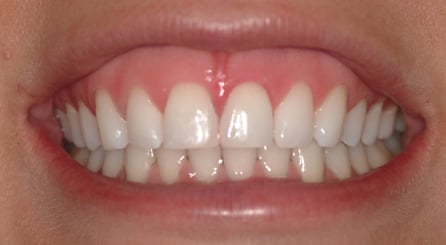
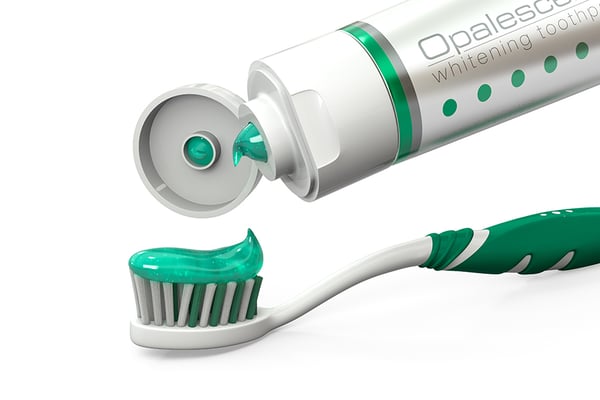
For more information on healthy and effective professional tooth whitening, visit Opalescence.com.
1 Greenwall, L., Greenwall-Cohen, J. & Wilson, N. Charcoal-containing dentifrices. British Dental Journal 226, 697–700 (2019). https://www.nature.com/articles/s41415-019-0232-8#citeas


